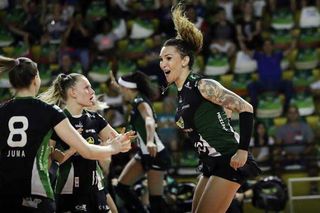
All the Arguments You Need: To Prove It’s Fair for Trans, Intersex Athletes to Compete in Consistence With Their Gender Identity
Bodies and gender identities aren’t binary, so why are sporting competitions?

Nowhere is the struggle between maintaining the traditional status quo of the gender binary, and moving forward toward greater inclusivity, more pronounced than in competitive sports, due to the differences in male and female physiology. But, there is enough science and data out there to suggest these differences aren’t nearly as stark as we’ve been led to believe — which means any argument against allowing trans and intersex people and people with differences in sex development (DSD) to compete against ciswomen is queerphobic at best. Here are all the arguments you need to fight for greater gender inclusivity in sport.
“Biological males have physical advantages over women such as more stamina, larger bones, and more muscle, so it’s unfair for trans women to compete with ciswomen.”
The science on what women’s bodies can do is flimsy at best. But consider what the female body can do better than a male body: “Women’s bodies have a lower center of gravity and therefore better balance; they tend to be more flexible, and their bodies more efficiently convert calories into energy giving them greater endurance,” Liesl Goeker writes for The Swaddle, while arguing for equal pay in sports. This gives women the upper hand in ultra-endurance running and gymnastics — just as male bodies have the upper hand when it comes to sports such as the shotput and 100m sprint that require speed and brute strength. But zero trans women who are gymnasts are complaining about the advantage cis women have, or saying they want to compete in the men’s category for endurance running or gymnastics — because they just want to participate in the sports category congruent with their gender identity.
Besides, sports isn’t ‘fair.’ It never was. Genetics isn’t either. Many elite athletes are genetically blessed in a way the average person isn’t. Basketball players have the advantage of height, and Michel Phelps’s very peculiar anatomy gives him the upper handin swimming. Privilege isn’t fair either — athletes of color are at a disadvantage when it comes to exposure, opportunities, and resources to even begin pursuing sports competitively, compared to Caucasian athletes. So, what is this “level playing field” argument but a myth spun by those allowed to play and win in the field, to maintain the status quo?
Related on The Swaddle:
New Report Outlines Scale of Homophobia, Transphobia in Sport
“Biological males have the advantage of testosterone that enhances performance so it’s unfair for trans women to compete with ciswomen.”
The science on physiological advantages male athletes have over female athletes is in a nascent stage. It’s important to preface this argument by pointing out that very little research and conversation is around, say, the advantages of estrogen (the hormone responsible for many physical characteristics of a typical female) or prolactin (the breastfeeding hormone) on athletic ability. The obsession is entirely with testosterone (T) — the hormone responsible for many glorified physical characteristics of a typical male — and the absurd question of at what level of testosterone does a female athlete become too good to be a woman.
For every credible study and statement out there that proves greater testosterone is linked to greater athletic ability in men and women, there are equally credible studies that prove testosterone is just one of the many factors that affect sporting ability — sometimes even negatively. Take the International Association for Athletics Federation’s data on elite women athletes. Its initial analysis of two world championships showed that women with higher T levels performed better in only five out of 21 events.
After an independent group of researchers took an issue with the research methodology to reach even this finding, the sports body was forced to issue a correction. In the corrected results, in three of 11 running events, the group with the lowest levels of T did better. Across all events, the association between T and performance was the strongest (and the most surprising) in the 100m sprint: athletes with lower T ran 5.4% faster than those with the highest levels of T. The independent group of researchers who objected to the results earlier concluded it’s “impossible” to discern the real relationship, if any, between T and performance. Clearly, though, neither this study nor the broader sports science literature supports the IAAF’s claim that targeted trans, intersex athletes “have the same advantages over [other] women as men do over women.”
Then there’s the stuff outside of the binary that science is nowhere close to explaining clearly, like Chand’s and Semenya’s hyperandrogenism (a medical condition where a typical female body produces higher testosterone than usual). Or, as Faryal Mirza, a clinical endocrinologist at the University of Connecticut Medical Center, tells Scientific American, sometimes high T simply means that a person isn’t very efficient at using T: the body is producing more precisely to arrive at “typical” function of someone producing T in the “typical range.”
Related on The Swaddle:
IAAF’s Caster Semenya Decision Arbitrarily Dictates What Is Female
A review of 31 national and international transgender sporting policies, including those of the International Olympic Committee, the Football Association, Rugby Football Union and the Lawn Tennis Association by researchers at the Scool of Sports Exercise and Health Sciences, Loughborough University concluded: “After considering the very limited and indirect physiological research that has explored athletic advantage in transgender people, we concluded that the majority of these policies were unfairly discriminating against transgender people, especially transgender females” by overinterpreting the “unsubstantiated belief” that testosterone improves athletic performance.
Thousands of trans athletes have been competing at national and international competitions who you just don’t hear about simply because they don’t all win or qualify for the Olympics even with all their apparent unfair advantages. This also proves the non-cisgender athletes who do go ahead and win medals owe their success more to their training, skill, perseverance, resilience, and a host of other reasons apart from their gender or sex, and especially from the myth of testosterone.
“Letting trans and intersex women compete in women’s sports will lead to many male athletes pretending to be women just so they can easily win.”
Yikes. Are we really suggesting there are numerous male athletes who will declare they identify as women, go through exhausting transition processes such as hormone replacement, gather the required medical and psychological proof of their fake gender dysmorphia (prolonged distress caused a mismatch between their biological sex and gender identity), go through their entire lives living under the pretense of being female, all while facing prejudice that trans people face on a daily basis — only for a few gold medals and some cash?
Notwithstanding the paranoia (looking at you Martina Navratilova), this argument is the literal definition of transphobia. This idea — that we should ban all innocent and real trans and intersex women based solely on the fantastic hypothetical of the fraudulent cis man — has roots in an irrational fear of the other (in this case, non-cisgender people) based on prejudice or ignorance.
Laws and rules can always be misused, irrespective of gender. But, we can’t deny people’s rights simply because a few could, in theory, game the system. Look at it this way: are some people falsely framed for murder? Yes. Does that mean we don’t have any rules to punish the crime? Of course not.
This debate doesn’t even have to be esoteric; there is actual data to prove male athletes aren’t queuing up to declare a new gender identity. In 2003, the International Olympic Committee adopted the Stockholm Consensus (SC) allowing the inclusion of trans athletes who had undergone sex reassignment, making it possible for trans athletes to compete in the Olympics from 2004. The IOC modified these guidelines in 2015 to put a cap on testosterone levels for trans womenathletes. And yet, despite the fact that more than 50,000 athletes have participated in the Olympics since 2004, no trans athlete has ever been a part of the Olympics until now, real or fake. So, clearly including trans athletes in sports won’t make the sky fall.
Related on The Swaddle:
Explaining the Vocabulary of the Gender Spectrum
“If not men’s and women’s sports categories, then how do we organize sports fairly?”
Creating a third, mixed category for trans, non-binary, cis men and women to compete against each other can be an earnest, motivating place to start making sports more inclusive. Mixed-gender sports teams are a widely debated topic and have been for many years, just not in relation to opportunities for transgender people. But, introducing more mixed-gender sports teams would also facilitate accessibility for transgender people.
The IOC did well, when in June 2017, it added mixed-sex events in athletics, swimming, table tennis, and triathlon to the upcoming Summer Olympics schedule in Tokyo 2020, in addition to the traditional categories. This not only allows trans and intersex athletes to compete in the sports category congruent with their gender identity based on their athletic ability alone, Tokyo 2020’s milestone mixed-sex events are a concrete step towards ungendering sports. (It is important here to note this will all be moot unless the IOC allows trans and intersex athletes to compete — in these mixed events at least — without having to meet any criteria other than being a human adult who’s good enough to qualify.)
Another way to organize sports, as suggested by Alison Heather, a physiologist at the University of Otago in New Zealand, and her colleagues in an essay published in the Journal of Medical Ethics, would be to create a system that uses an algorithm to account for physiological factors such as testosterone, height, and endurance, and social factors like gender identity and socioeconomic status. Sure it’s a Herculean task, but international sports bodies have enough money to at least begin research into the idea if it means a more inclusive world.
Apart from this, sports can also be organized on the basis of other factors such as weight class, professional/amateur status, and size. The idea is that through a mixture of formats, we redesign sports to make them more inclusive.
It’s going to take fresh thinking and self-awareness that what we believe to be facts about sex and gender are not unquestionable. But every individual must have the possibility of practicing sport, without discrimination of any kind, and in the spirit which requires mutual understanding, with a spirit of friendship, solidarity and fair play. Those are not my words, that’s the Olympic charter.
Pallavi Prasad is The Swaddle's Features Editor. When she isn't fighting for gender justice and being righteous, you can find her dabbling in street and sports photography, reading philosophy, drowning in green tea, and procrastinating on doing the dishes.
Related


Little Big Things: A 25‑Year‑Old’s Shift From Being Apolitical to Protesting NRC‑CAA
